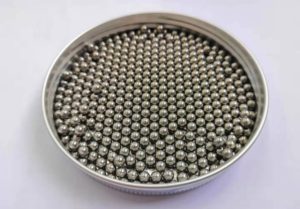The surface reaction layer of titanium plate and rod is the main factor affecting the physical and chemical properties of titanium workpiece. Before processing, the surface contamination layer and defect layer must be completely removed. Physical-mechanical polishing of surface polishing process of titanium plate and rod:

- Sandblasting:
White corundum is usually used for sand blasting treatment of titanium wire castings, and the pressure of sand blasting is smaller than that of non-precious metals, which is generally controlled below 0.45 MPa. Because, when the injection pressure is too high, the sand particles impact the titanium surface to produce intense sparks, and the temperature rise can react with the titanium surface, resulting in secondary pollution and affecting the surface quality. The time is 15-30 seconds. Only the adhering sand, sintered layer and partial oxide layer on the surface of the castings can be removed. The other surface reaction layer structures should be removed quickly by chemical acid pickling.
- pickling:
Acid pickling can quickly and completely remove the surface reaction layer, and the surface will not produce pollution of other elements. HF-HCL and HF-HNO_3 acid pickling solutions can be used for titanium pickling, but HF-HCL acid pickling solution has a large hydrogen absorption capacity, while HF-HNO_3 acid pickling solution has a small hydrogen absorption capacity, which can control the concentration of HNO_3 to reduce hydrogen absorption, and can brighten the surface. Generally, the concentration of HF is about 3%-5%, and the concentration of HNO_3 is about 15%-30%.
The surface reaction layer of titanium plate and rod can be completely removed by acid pickling after sandblasting.
In addition to physical and mechanical polishing, there are two kinds of reaction layers on the surface of titanium plate and rod: 1. chemical polishing and 2. electrolytic polishing.
- Chemical polishing:
In chemical polishing, the aim of leveling and polishing is achieved by the oxidation-reduction reaction of metal in chemical medium. Its advantages are that chemical polishing has nothing to do with metal hardness, polishing area and structure shape. All parts contacted with polishing fluid are polished without special complicated equipment. It is easy to operate and suitable for polishing of titanium denture support with complex structure. However, the process parameters of chemical polishing are difficult to control, which requires that the denture can be polished without affecting the accuracy of the denture. The better titanium chemical polishing solution is HF and HNO 3 in a certain proportion. HF is a reducing agent, which can dissolve titanium metal and play a leveling role. The concentration of HNO 3 is less than 10%. HNO 3 acts as an oxidizing agent to prevent excessive dissolution and hydrogen absorption of titanium, and at the same time it can produce a bright effect. Titanium polishing solution requires high concentration, low temperature and short polishing time (1-2 minutes).
- Electropolishing:
Also known as electrochemical polishing or anodic dissolution polishing, because of the low conductivity and strong oxidation performance of titanium alloy tubes, it is almost impossible to polish titanium using aqueous acidic electrolytes such as HF-H3PO4 and HF-H2SO4. When applied with external voltage, the titanium anode immediately oxidizes and the anodic dissolution cannot proceed. However, the anhydrous chloride electrolyte has a good polishing effect on titanium under low voltage. Small specimens can be polished specularly. However, for complex prostheses, the purpose of complete polishing can not be achieved. Maybe the method of changing the shape of cathode and adding cathode can solve this problem, which needs further study.
